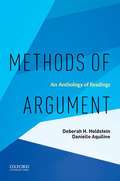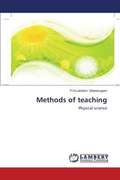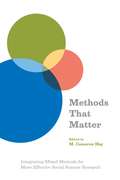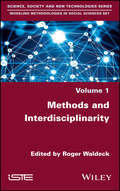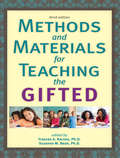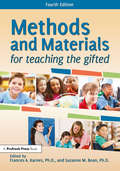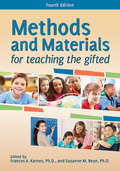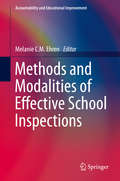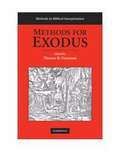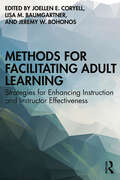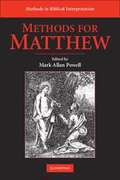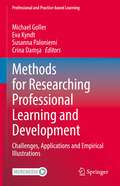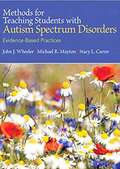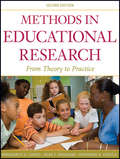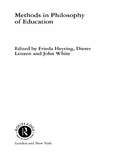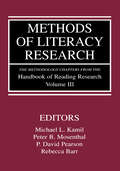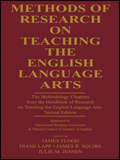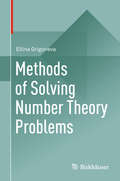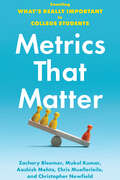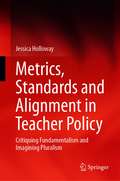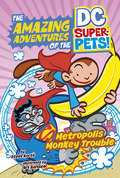- Table View
- List View
Methods Of Argument: An Anthology Of Readings
by Deborah Holdstein Danielle Aquiline"This reader is designed to support Composition II courses focused on methods and techniques of argument. The selections will model an array of critical thinking as well as argumentative writing techniques by which one can argue a single point of view and also more complex, mixed forms of argumentation. The goal will always be to model how a student may respond, in writing and discussion, with an accountable, well-supported viewpoint. In a current climate of 'fake news' and 'alternative facts,' this reader provides a timely and compelling context in which to offer students opportunities to craft reasoned arguments with evidence. Selections will be framed by an introduction featuring a narrative on analyzing and writing arguments, the importance of accountability (including challenging others' less-than-compelling arguments), and information on the reading and writing process. Selections themselves will comprise both classic and contemporary sources and be diverse in origin, genre, and topic"--
Methods Of Teaching
by P.N. Lakshmi ShanmugamThis book “METHODS OF TEACHING “ covers various methods of teaching in Physical Science as creative and engaging as possible. Students get the most out of their learning when it is exciting and this book offers great ideas for classroom practice, which are carefully linked to research. It helps the students in achieving higher teaching competence through microteaching. It becomes a key for unlocking new perspectives in the process of training. Various methods of teaching like lecture, lecture cum demonstration, project, seminar, team teaching and scientific method help the teachers to teach lessons in real conditions. Illustrations from physical science is the most influential innovation to teachers for improving effectiveness of the existing teaching skill.
Methods That Matter: Integrating Mixed Methods for More Effective Social Science Research
by M. Cameron HayTo do research that really makes a difference--the authors of this book argue--social scientists need questions and methods that reflect the complexity of the world. Bringing together a consortium of voices across a variety of fields, Methods that Matter offers compelling and successful examples of mixed methods research that do just that. In case after case, the researchers here break out of the traditional methodological silos that have long separated social science disciplines in order to better describe the intricacies of our personal and social worlds. Historically, the largest division between social science methods has been that between quantitative and qualitative measures. For people trained in psychology or sociology, the bias has been toward the former, using surveys and experiments that yield readily comparable numerical results. For people trained in anthropology, it has been toward the latter, using ethnographic observations and interviews that offer richer nuances of meaning but are difficult to compare across societies. Discussing their own endeavors to combine the quantitative with the qualitative, the authors invite readers into a conversation about the best designs and practices of mixed methodologies to stimulate creative ideas and find new pathways of insight. The result is an engaging exploration of a promising new approach to the social sciences.
Methods and Interdisciplinarity
by Roger WaldeckInterdisciplinarity research results from a growing need for multi-perspective methods, and knowledge on complex and multifaceted objects of study. It is not simply scientific research that involves several disciplines, but ultimately, the aim is confronting this knowledge and – if possible – articulating it coherently. Using specific examples, Methods and Interdisciplinarity categorizes the different modes of interdisciplinarity and discusses the mechanisms of hybridization between them. On the one hand, the book shows how the same issue can be treated according to various points of view from several disciplines, which can give rise to complementary or even contradictory knowledge. On the other hand, it illustrates how methods from some disciplines make it possible to articulate the qualitative or quantitative approaches of others.
Methods and Materials for Teaching the Gifted
by Frances A. Karnes M. Bean SuzanneFor teachers at the elementary and secondary levels, this guide outlines strategies for teaching gifted learners. Karnes (curriculum, instruction, and special education, U. of Southern Mississippi) and Bean (education, Mississippi U. for Women) bring together 23 chapters that cover the characteristics and needs of gifted learners, curricular design, process skills development, instructional units, evaluating outcomes, supporting and enhancing gifted programs, and practices such as problem-based learning, creative teaching strategies, independent study, mentorships, and classroom simulations. Chapter authors are scholars, researchers, and consultants in gifted education in the US. In addition to being revised and expanded, this edition includes teacher statements and discussion questions in each chapter. Annotation ©2009 Book News, Inc. , Portland, OR (booknews. com)
Methods and Materials for Teaching the Gifted
by Frances A. Karnes Suzanne M. BeanThe newly revised and updated fourth edition of Methods and Materials for Teaching the Gifted is an excellent introduction to gifted education and real-world learning. The chapters of this comprehensive textbook are written by respected leaders in the field of gifted education. The authors review the unique needs of gifted learners and give current information on instructional planning and evaluation, strategies for best practices, and ongoing enhancement and support of gifted programs. Chapters include topics such as differentiated curricular design, extending learning through research, writing challenging instructional units, and developing leadership skills and innovative thinkers. Instructional practices such as problem-based learning, technology literacy, independent study, simulation and gaming, and more are addressed. A special focus is given to using the Gifted Education Programming Standards and Common Core State Standards. The fourth edition provides updated information on funding sources and public relations strategies for gifted education programs. It also includes updated lists of books, teaching materials, websites, and other resources for teachers of the gifted.
Methods and Materials for Teaching the Gifted
by Jennifer L. Jolly Frances A. Karnes Suzanne M. Bean Jennifer H. RobinsThe completely revised and updated fifth edition of Methods and Materials for Teaching the Gifted:Provides a comprehensive examination of the most current research and best practices in the field of gifted education.Addresses identification, twice-exceptionality, and culturally and linguistically diverse learners.Includes chapters related to designing curriculum and differentiating instruction.Covers developing critical and creative thinking, as well as encouraging talent development.Features chapter authors who are recognized researchers, practitioners, and leaders in the field of gifted education.The chapters are organized to promote critical thinking and discussion about each topic. This text is a complete resource curated for a wide range of K-12 educators and those working with inservice and preservice educators and administrators.
Methods and Materials for Teaching the Gifted
by Frances Karnes Suzanne BeanThe newly revised and updated 'Methods and Materials for Teaching the Gifted' offers strategies and resources for differentiating instruction for gifted learners. The book acts as an excellent introduction to gifted education curricular planning, instructional unit design, evaluation, and teaching methods. The chapters of this comprehensive textbook are written by respected leaders in the field of gifted education. The authors review the needs ofgifted learners, instructional planning and evaluation, strategies for best practices, and ongoing enhancement and support of gifted programs. Chapters include topics such as differentiated curricular design, extending learning through mentorships, building challenging instructional units, and developing creative thinking. Also, instructional practices, such as problem-based learning, independent study, classroom simulations, and more are addressed. The third edition includes a brand-new chapter on educational technology for the gifted, as well as updated information on books, teaching materials, Web sites, and other resources for differentiating instruction and planning gifted education curriculum. Educational Resource
Methods and Materials for Teaching the Gifted (Other Ser.)
by Jennifer Jolly Jennifer RobinsThe completely revised and updated fifth edition of Methods and Materials for Teaching the Gifted:Provides a comprehensive examination of the most current research and best practices in the field of gifted education.Addresses identification, twice-exceptionality, and culturally and linguistically diverse learners.Includes chapters related to designing curriculum and differentiating instruction.Covers developing critical and creative thinking, as well as encouraging talent development.Features chapter authors who are recognized researchers, practitioners, and leaders in the field of gifted education.The chapters are organized to promote critical thinking and discussion about each topic. This text is a complete resource curated for a wide range of K-12 educators and those working with inservice and preservice educators and administrators.
Methods and Modalities of Effective School Inspections
by Melanie C.M. EhrenThis book provides an overview anddiscussion of the evidence base of effective school inspections; reflecting on issuesof validity and reliability of school inspections in relation to schooleffectiveness research, unintended consequences and emergent roles andresponsibilities of Inspectorates of Education. Chapters include findings from systematicliterature reviews and primary research while also presenting a range ofpractical examples from inspections systems from all over the world. The bookprovides relevant background materials for Inspectorates of Education who aimto improve the effectiveness of their systems and working methods, as well as clearexamples for researchers aiming to analyse and understand the effectiveness ofthese systems. The final chapter reflects on changes in the currenteducation landscape and discusses newer models of school inspections that fitwithin a more decentralized inspection system.
Methods for Exodus
by Thomas B. DozemanMethods for Exodus is a textbook on biblical methodology. The book introduces readers to six distinct methodologies that aid in the interpretation of the book of Exodus: literary and rhetorical, genre, source and redaction, liberation, feminist, and postcolonial criticisms. Describing each methodology, the volume also explores how the different methods relate to and complement one another. Each chapter includes a summary of the hermeneutical presuppositions of a particular method with a summary of the impact of the method on the interpretation of the book of Exodus. In addition, Exodus 1-2 and 19-20 are used to illustrate the application of each method to specific texts. The book is unique in offering a broad methodological discussion with all illustrations centered on the book of Exodus.
Methods for Facilitating Adult Learning: Strategies for Enhancing Instruction and Instructor Effectiveness
by Joellen E. Coryell, Lisa M. Baumgartner Jeremy W. BohonosThis book equips instructors with fresh, practical teaching and training methods to support adult learning in both formal and continuing educational environments.An extensive, how-to guide, Methods for Facilitating Adult Learning covers adult teaching and learning fundamentals, collaborative teaching methods, methods for facilitating autonomous learning, community-based teaching methods, and technology-enhanced teaching and learning approaches. Readers will emerge with an in-depth understanding of each method, made comprehensive by the inclusion of definitions, philosophical and/or theoretical underpinnings, advantages and limitations, practical guidelines for application, and ample real-world examples.Ideal for any educator working with adult learners, this book offers a toolbox of approaches designed to enhance reader understanding and practice of adult instruction.
Methods for Matthew
by Mark Allan PowellToday's biblical scholars study the Gospel of Matthew with a wide variety of methods that yield diverse and exciting insights. Methods for Matthew offers a primer on six exegetical approaches that have proved to be especially useful and popular. In each case, a prominent scholar describes the principles and procedures of a particular approach and then demonstrates how that approach works in practice, applying it to a well-known text from Matthew's Gospel. As an added bonus, each of the chosen texts is treated to three different interpretations so that the reader can easily compare the results obtained through one approach to those obtained through other approaches. The reader will learn a great deal about two stories from Matthew ("the healing of a centurion's servant" and "the resurrection of Jesus") and the reader will also learn enough about each of these six approaches to understand their function in biblical studies today.
Methods for Researching Professional Learning and Development: Challenges, Applications and Empirical Illustrations (Professional and Practice-based Learning #33)
by Eva Kyndt Michael Goller Susanna Paloniemi Crina DamşaThis volume provides alternatives for tackling existing empirical, methodological, and analytical challenges. It does so by providing a broad overview of less established, as well as emerging methods, which are of great relevance for current research on professional learning and development. As such, it offers a comprehensive collection of state-of-the-art methodologies and future directions within the workplace learning and professional development research. By describing these novel approaches and providing empirical illustrations, the book promotes innovative methodologies for investigating professional learning and development. It also supports scholars to understand upcoming empirical research and methods and encourages novice as well as established researchers to adopt new empirical strategies beyond traditional ones that have the potential to enrich a better understanding of professional learning and development.
Methods for Teaching Students With Autism Spectrum Disorders: Evidence-Based Practices
by Stacy L. Carter John J. Wheeler Michael R. MaytonMethods for Teaching Students with Autism Spectrum Disorders is the most comprehensive text available, aimed at helping pre-service and in-service teachers and related service professionals understand the importance of evidence-based practices in the education of learners with Autism Spectrum Disorders (ASD) from a family and longitudinal learning perspective. <p><p>With its emphasis on the theme of family and professional partnerships and collaboration and consultation, the book includes learning aids such as suggested print and web-based resources, graphic organizers, and points for reflection; child and family vignettes, “Consider This” features, and examples of exemplary programs and practices; and the most up-to-date information and latest trends in the field.
Methods for Teaching in Early Education: Contexts for Inclusive Classrooms
by Erin E. Barton Jennifer Ledford Justin D. LaneMethods for Teaching in Early Education is a comprehensive textbook offering a thorough introduction to early childhood teaching methods, with a particular focus on inclusive practices. Aligned with both NAEYC standards and CEC’s Division for Early Childhood recommended practices, this text explores various early childhood teaching principles and strategies, providing useful guidance for identifying and choosing between approaches. Covering topics from child-directed strategies to working with professionals in early childhood, the authors provide extensive support to prepare teachers for classroom planning and instruction. Each chapter opens and closes with representative vignettes of the challenges faced by today’s early educators, and helpfully highlights key terms and objectives to inform learning goals. With the addition of sample worksheets, suggested exercises and helpful references, this book fully supports future teachers in understanding how they might implement these strategies in practice. Methods for Teaching in Early Education will prove indispensable for students of teaching methods courses in both general and special education programs, providing a comprehensive introduction to early childhood teaching strategies relevant for today’s inclusive classrooms.
Methods in Bilingual Reading Comprehension Research
by Jeanette Altarriba Roberto R. Heredia Anna B. CieślickaThe collected essays in this volume present an overview and state-of-the-field of traditional and recently developed methodological approaches to the study of bilingual reading comprehension. It critically reviews and examines major findings from classical behavioral approaches such as the visual moving window, rapid-serial visual presentation (RSVP), and eye-tracking, as well as newly developing neuropsycholinguistic methodologies such as Event-Related Potentials (ERPS), and Functional Magnetic Resonance Imaging (fMRI). Written to address a timely topic, Methods in Bilingual Reading Comprehension Research updates the field of bilingual reading by critically examining the contributions of the various behavioral and technologically-based reading techniques used to understand psychological processes underlying written language comprehension. Each topic is covered first from a theoretical, and then from an experimental, viewpoint. Moreover, the volume contributes to the development and establishment of Bilingual Reading as a subfield of bilingual sentence processing and fills a significant gap in the literature on bilingual language processing and thought. Significantly, Methods in Bilingual Reading Comprehension Research presents an overall view of some of the typical psycholinguistic techniques and approaches, as well as proposing other possible tasks that may prove viable in investigating such theoretical issues as bilingual lexical ambiguity resolution, or how bilingual speakers might resolve multiple sources of potentially conflicting information as they comprehend sentences and discourse during the communicative process. In addition, to aid reader comprehension and encourage readers to acquire "hands on" experience in the creation and development of experiments in the realm of bilingual reading research, each chapter includes a list of key words, suggested student research projects, and questions to both help the reader review the chapter and expand upon the reading. With its comprehensive coverage of a crucial subfield of psycholinguistics and language processing, Methods in Bilingual Reading Comprehension Research is an invaluable and informative resource for all students and researchers in bilingualism, neurolinguistics, bilingual cognition, and other related fields.
Methods in Educational Research
by Dean T. Spaulding Katherine H. Voegtle Marguerite G. LodicoMethods in Educational ResearchMethods in Educational Research is designed to prepare students for the real world of educational research. It focuses on scientifically-based methods, school accountability, and the professional demands of the twenty-first century, empowering researchers to take an active role in conducting research in their classrooms, districts, and the greater educational community. Like the first edition, this edition helps students, educators, and researchers develop a broad and deep understanding of research methodologies. It includes substantial new content on the impact of No Child Left Behind legislation, school reform, quantitative and qualitative methodologies, logic modeling, action research, and other areas. Special features to assist the teaching and learning processes include vignettes illustrating research tied to practice, suggested readings at the end of each chapter, and discussion questions to reinforce chapter content.Praise for the Previous Edition"A new attempt to make this subject more relevant and appealing to students. Most striking is how useful this book is because it is really grounded in educational research. It is very well written and quite relevant for educational researchers or for the student hoping to become one." -PsycCRITIQUES/American Psychological Association"I applaud the authors for their attempt to cover a wide range of material. The straightforward language of the book helps make the material understandable for readers." -Journal of MultiDisciplinary Evaluation
Methods in Philosophy of Education (Routledge International Studies in the Philosophy of Education #Vol. 13)
by John White Dieter Lenzen Frieda HeytingThis important new book presents a 'dual strand' argument: Firstly, it gives a comprehensive account of methods in philosophy of education, with leading international figures in the field of writing from a variety of methodological and epistemological perspectives. Secondly, it examines their application in the 'real world' of education, using the topical area of children's rights as a basis for investigation. It will therefore be of interest to philosophers and educationalists alike.
Methods of Literacy Research: The Methodology Chapters From the Handbook of Reading Research, Volume III
by P. David Pearson Michael L. Kamil Peter B. Mosenthal Rebecca BarrIn this volume, 10 reviews of significant reading research methodologies are reprinted from the Handbook of Reading Research, Volume III. The editors have judged that these specific methodologies have had great impact on reading research since the publication of Volume II in 1991. This text is especially well-suited for use in upper-level undergraduate and graduate-level reading research methods courses.
Methods of Research on Teaching the English Language Arts: The Methodology Chapters From the Handbook of Research on Teaching the English Language Arts, Sponsored by International Reading Association & National Council of Teachers of English
by James Flood Diane Lapp James R. Squire Julie M. JensenThis text makes available in a concise format the chapters comprising the research methodology section of the Handbook of Research on Teaching the English Language Arts, Second Edition. An introduction, designed to give K-12 teachers an understanding of the basic categories and functions of research in teaching, is followed by chapters addressing teacher professionalism and the rise of "multiple literacies"; empirical research; longitudinal studies; case studies; ethnography; teacher research; teacher inquiry into literacy, social justice, and power; synthesis research; fictive representation; and contemporary methodological issues and future direction in research on the teaching of English. Methods of Research on Teaching the English Language Arts is well-suited for use in upper-level undergraduate and graduate-level literacy research methods courses.
Methods of Solving Number Theory Problems
by Ellina GrigorievaThrough its engaging and unusual problems, this book demonstrates methods of reasoning necessary for learning number theory. Every technique is followed by problems (as well as detailed hints and solutions) that apply theorems immediately, so readers can solve a variety of abstract problems in a systematic, creative manner. New solutions often require the ingenious use of earlier mathematical concepts - not the memorization of formulas and facts. Questions also often permit experimental numeric validation or visual interpretation to encourage the combined use of deductive and intuitive thinking. The first chapter starts with simple topics like even and odd numbers, divisibility, and prime numbers and helps the reader to solve quite complex, Olympiad-type problems right away. It also covers properties of the perfect, amicable, and figurate numbers and introduces congruence. The next chapter begins with the Euclidean algorithm, explores the representations of integer numbers in different bases, and examines continued fractions, quadratic irrationalities, and the Lagrange Theorem. The last section of Chapter Two is an exploration of different methods of proofs. The third chapter is dedicated to solving Diophantine linear and nonlinear equations and includes different methods of solving Fermat’s (Pell’s) equations. It also covers Fermat’s factorization techniques and methods of solving challenging problems involving exponent and factorials. Chapter Four reviews the Pythagorean triple and quadruple and emphasizes their connection with geometry, trigonometry, algebraic geometry, and stereographic projection. A special case of Waring’s problem as a representation of a number by the sum of the squares or cubes of other numbers is covered, as well as quadratic residuals, Legendre and Jacobi symbols, and interesting word problems related to the properties of numbers. Appendices provide a historic overview of number theory and its main developments from the ancient cultures in Greece, Babylon, and Egypt to the modern day. Drawing from cases collected by an accomplished female mathematician, Methods in Solving Number Theory Problems is designed as a self-study guide or supplementary textbook for a one-semester course in introductory number theory. It can also be used to prepare for mathematical Olympiads. Elementary algebra, arithmetic and some calculus knowledge are the only prerequisites. Number theory gives precise proofs and theorems of an irreproachable rigor and sharpens analytical thinking, which makes this book perfect for anyone looking to build their mathematical confidence.
Metrics That Matter: Counting What's Really Important to College Students
by Mukul Kumar Christopher Newfield Zachary Bleemer Aashish Mehta Chris MuellerleileColleges sell themselves by the numbers—rankings, returns on investments, and top-ten lists—but these often mislead prospective students. What numbers should they really be paying attention to?High school and college students are inundated by indicators and rankings supposedly designed to help them decide where to go to college and what to study once they arrive. In Metrics That Matter, coauthors Zachary Bleemer, Mukul Kumar, Aashish Mehta, Chris Muellerleile, and Christopher Newfield take a critical look at these metrics and find that many of the most popular ones are confusing, misleading, and—most importantly—easily replaceable by more helpful alternatives. Metrics That Matter explores popular metrics used by future and current college students, with chapters focusing on colleges' return on investment, university rankings, average student debt, average wages by college major, and more. Written for students, their families, and the counselors who advise them, each chapter explains a common metric's fundamental flaws when used as a basis for making important educational decisions. The authors then draw on decades of scholarship from many academic fields to pair each metric with a concrete recommendation for alternative information, both qualitative and quantitative, that would be more useful and meaningful for students to consider. They emphasize that students should be thinking beyond solely using metrics when making college decisions—students should focus on their intellectual and academic education goals, not just vocational or monetary ones.Students' reliance on certain metrics has skewed universities away from providing high-quality education and distorted the perception of higher education's purpose, overemphasizing private financial returns over the broader economic and social benefits of universities. This book aims to facilitate important student decisions while reorienting public perceptions of higher education's values and how universities should measure their own success.
Metrics, Standards and Alignment in Teacher Policy: Critiquing Fundamentalism and Imagining Pluralism
by Jessica HollowayThis book looks at the narrowing effects of contemporary modes of teacher and teaching policy and governance. It draws on political theory to provide new ways of conceptualising the effects of teacher and teaching policies and practices. It adds a new dimension to the robust body of literature related to teacher policy by looking at three interrelated domains: (1) teacher preparation and development, (2) teacher evaluation and (3) teacher leadership.Drawing from case studies from the USA, UK and Australia, it illustrates how a coalescence around metrics, standards and compliance is producing increasingly restricted notions of teachers and teaching. It shows how the rationalities and techniques associated with accountability and standardisation are limiting the possibilities for multiple conceptualisations of teaching and teachers to exist or emerge. Using pluralism as the main framework, it challenges the dangers associated with rigid compliance and alignment and argues that pluralism can help secure schools as socially and culturally responsive to the needs of the community.
Metropolis Monkey Trouble (The Amazing Adventures of the DC Super-Pets)
by Steve KorteA chunk of Kryptonite has turned Superman into a wild animal! He’s on the streets and looking to make monkey trouble. Can Beppo the Super-Monkey stop him from making Metropolis his playground?
